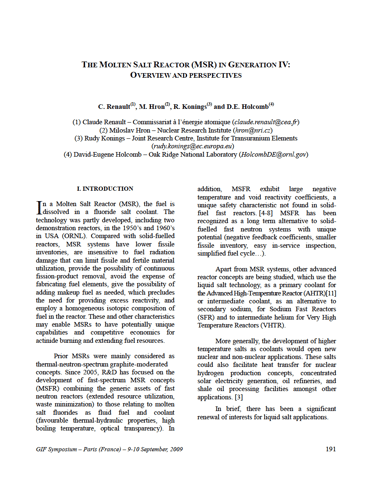Reclaiming Nuclear Innovation: The Molten Salt Reactor’s Strategic Edge
What the MSFR and AHTR concepts reveal about energy independence, proliferation resistance, and advanced fuel utilization
EGENERATION LIBRARY
👥 Authors
The paper was authored by the following experts:
Claude Renault – Commissariat à l'énergie atomique (CEA), France
Miloslav Hron – Nuclear Research Institute, Czech Republic
Rudy Konings – Joint Research Centre, Institute for Transuranium Elements, EU
David-Eugene Holcomb – Oak Ridge National Laboratory, USA
Major contributions were also noted from:
E. Merle-Lucotte and S. Delpech (CNRS, France)
V. Ignatiev (RRC-KI, Russia), for input on ISTC MSR projects
🧪 Summary
Presented at: GIF Symposium – Paris, France, 9–10 September 2009
This paper delivers a high-level international overview of the Molten Salt Reactor (MSR) as one of the promising Generation IV nuclear reactor concepts. It focuses on the MSFR (Molten Salt Fast Reactor) and AHTR (Advanced High Temperature Reactor) pathways, highlighting their design features, R&D status, and projected benefits for next-generation nuclear energy.
Key Highlights:
🔥 MSR and MSFR Technology
MSRs use molten fluoride salts as both fuel and coolant, enabling unique advantages over solid-fuel reactors:
Continuous fission product removal
High-temperature operation
Negative temperature and void reactivity coefficients (a major safety improvement)
Easier refueling and material utilization
MSFR: A fast-spectrum reactor, with a graphite-free core and a eutectic salt mixture of LiF and actinide fluorides. Offers excellent safety due to strong negative feedback coefficients and has potential for actinide burning and breeding.
♻️ Fuel Cycle Innovation
Two startup options:
233U-started MSFR with a 50-year doubling time
TRU-started MSFR with 35 years
Advanced fuel salt clean-up schemes involve both on-line gaseous extraction (e.g., for Xe, Kr) and batch chemical/electrochemical separation for lanthanides and actinides.
🧱 Materials and Salt Chemistry
Extensive work on identifying optimal carrier salt compositions (e.g., ⁷LiF-BeF₂, ⁷LiF-ThF₄) for both fuel and coolant roles.
Corrosion resistance, solubility, thermal properties, and fission product behavior remain key R&D focus areas.
🔬 Experimental Validation
The SPHINX Project at the LR-0 reactor (Czech Republic) supports MSR and AHTR neutronics validation.
AHTR studies focus on pebble bed reactors with graphitic matrix fuel and salt coolants, demonstrating promising thermal efficiency and power density improvements.
🌐 International Collaboration
Coordinated through Generation IV International Forum (GIF), involving Europe (EURATOM), France, USA, and support from Russian institutes and ISTC.
Collaboration emphasizes cross-cutting needs in salt chemistry, structural materials, reactor physics, and safety.
Click on the document image to view or download the document!




